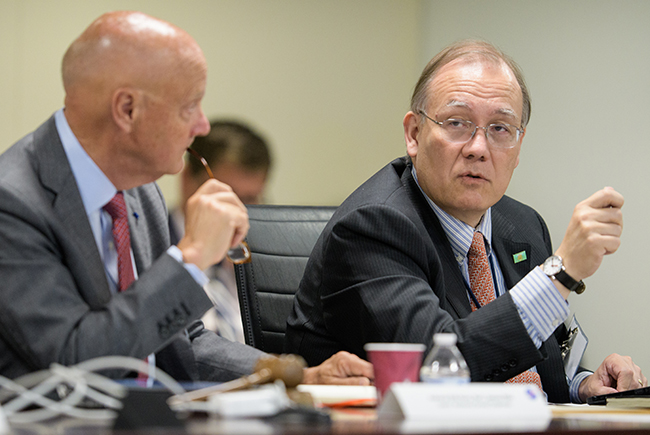
Scott Pace, executive secretary of the National Space Council and a top space adviser to the Trump administration—shown here at NASA's Washington, D.C., headquarters in June 2018—is pushing Congress to include the Pentagon's Space Force proposal in the fiscal 2020 National Defense Authorization Act as lawmakers mull potential changes. NASA photo by Joel Kowsky.
COLORADO SPRINGS, Colo.—National Space Council Executive Secretary Scott Pace is urging Congress to take up the Space Force proposal as part of the fiscal 2020 defense policy bill, instead of considering it under standalone legislation as a key House lawmaker has suggested.
“We think that this should be integrated into the National Defense Authorization Act,” Pace said Tuesday at the Space Foundation’s annual Space Symposium here. “We don’t believe in a standalone bill. We think this really is, can, and should be part of the NDAA discussions.”
Last month, House Armed Services Committee Chairman Rep. Adam Smith (D-Wash.) said he would “look at other potential legislative options,” either as part of the NDAA or in a separate bill. Politico reported the House could even bring up the original Space Corps bill it considered years ago.
The Pentagon’s proposal offered legislative language that could plug into the mammoth annual text, but lawmakers have raised questions about the abilities it gives the military to move money around, its role in overseeing space programs now owned by the services, and the officials who would run it.
Pace said Congress shouldn’t quash the Trump administration’s intent to eventually make the Space Force a department independent of the Air Force—an idea disliked by some, including Air Force Secretary Heather Wilson.
“That’s really the only way we get at supporting the people in the way we think is necessary,” he said. “One could work a lot of different other things to do improvements and have some beneficial changes for our military space activities, but a path with and onto a separate armed service … is pretty basic.”
He declined to comment on possible tweaks that would help or hurt the proposal, which the Defense Department submitted to Congress last month: “One of the rules, of course, is not to negotiate in public.” But he lauded the discussions long underway between Capitol Hill and the Pentagon, despite lingering concerns about the cost, added bureaucracy, and overall usefulness of creating a new group to organize, train, and equip space warfighters.
“I don’t by any means claim that it’s completely done, but we’re … arguing how to do this, which I think is very encouraging,” Pace said, adding that there are no perfect answers here. “There’s a lot of ways to get there. I’m optimistic.”
In a speech at the symposium, Acting Defense Secretary Patrick Shanahan outlined how the Space Force will establish a new framework for promoting, educating, and recruiting space personnel that isn’t an afterthought to air, land, and sea education.
“The Space Force will build a professional development system that recruits technical talent, educates them in space from the beginning, and provides a clear promotion path,” he said in prepared remarks. “Organizing and equipping includes force design and force development. This means understanding the domain, the technology, and warfare deeply enough to design future capabilities and then deliver them.”
A potential sixth military service would be supervised by a civilian undersecretary for space and a Chief of Staff who would join the Joint Chiefs. As part of the Pentagon’s three-pronged approach to future space operations, they would work closely with leaders at the revived US Space Command and with Fred Kennedy, who was tapped to lead the fledgling Space Development Agency.
The department is ready to stand up SPACECOM as soon as Congress takes up USAF Gen. Jay Raymond’s nomination to lead the organization, Shanahan added. If confirmed, Raymond will be dual-hatted as the commander of both SPACECOM and Air Force Space Command.